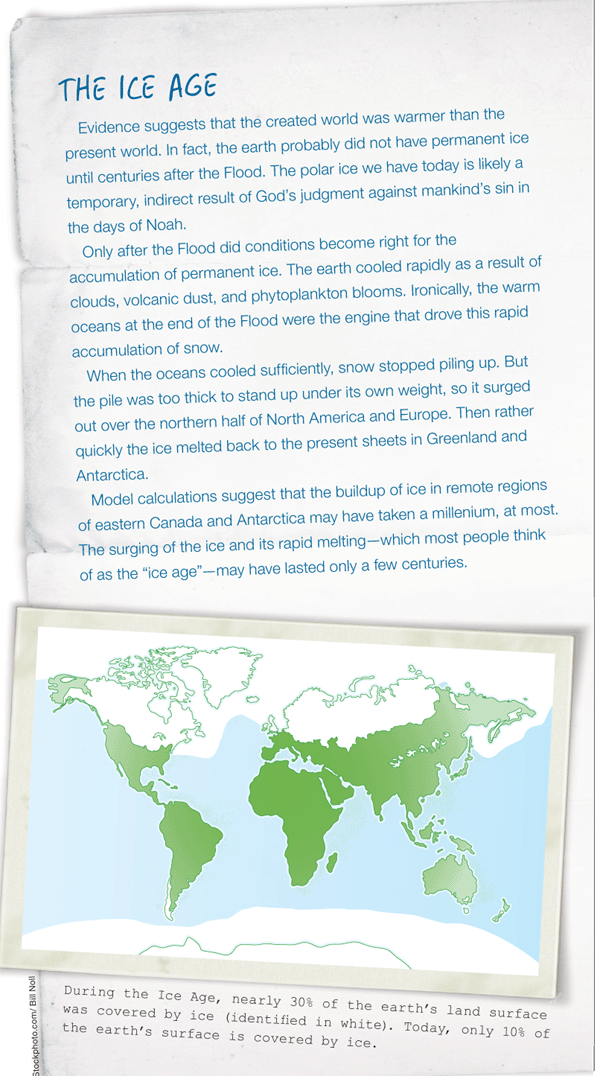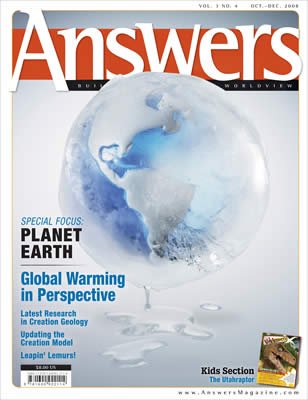
A Dark and Stormy World
The greatest weather catastrophe in earth history—that’s a good way to describe the Flood. The Flood caused radical changes in the land, seas, and atmosphere, the weather would never be the same. In fact, it took centuries before the climate settled into the relative stability we see today. The lesson? Our earth has still not fully recovered from the Flood!
Most people envision Noah and his family stepping off the Ark into a warm and sunny world. They imagine balmy breezes and the fragrant aroma of plants and trees just beginning to bloom. The end of the catastrophic, worldwide Flood must have been a dramatic relief to Noah’s family, but it doesn’t mean they were greeted by a gentle spring day.
A Recipe for Disaster—Warm Oceans and Cool Continents
As a result of the Flood the earth was out of balance, and it would take some time to set itself right. Because the atmosphere, the ocean, and the earth’s crust were not yet in equilibrium, the weather probably took many years to reach the shaky stability we experience today.
Just imagine. The surface of the earth was torn apart by the events of the Flood, and no forests or grasslands graced the barren landscape. The trees had been destroyed or buried under tons of sediment. The desolate land probably reflected much more light than it does today (a phenomenon known as albedo), causing colder temperatures over the continents.
During Noah’s Flood the earth experienced unparalleled catastrophes that released an incredible amount of heat. Continents separated, massive volcanoes erupted, mountains rose and fell, continents eroded away, and hot magma bubbled up from the mantle to the earth’s surface.
This heat was likely thoroughly mixed and stored in the oceans for hundreds of years after the Flood. Volcanic dust continued to spew into the atmosphere for many years, reducing the sun’s heating. Mountains rose, changing the topography and causing massive landslides in their wake. Earthquakes of extreme magnitude frequently shook the earth’s crust, slowly declining in frequency and intensity.
More clouds likely covered the earth immediately after the Flood, reflecting solar radiation back into space. Phytoplankton grew rapidly in the ocean because of the warm water and high concentrations of nutrients. This bloom probably reduced the carbon dioxide in the atmosphere, greatly contributing to global cooling. Consequently, the temperatures over the continents were probably much colder than we experience today.
Hypercanes
The temperature contrast between the oceans and the continents would have produced highly energetic storms. We know today that warm oceans form intense hurricanes that devastate any forests or manmade structures that get in their way when they hit land.
For several hundred years after the Flood it’s likely that even larger hurricanes than we experience today, called hypercanes, formed in both hemispheres, lashing the continents all the way from near the equator half way to the poles. Winds up to 500 miles per hour (805 km/h) and rainfall up to 50 inches per hour (127 cm/h) may have eroded loose sediments on the continents and continued to scour the landscape in muddy torrents, year after year, as plants tried to reestablish themselves.

The warm oceans would also have evaporated large quantities of water vapor into the atmosphere, which fell as rain near the equator and low elevations, and as snow near the poles and high elevations. Model calculations show that ice sheets and glaciers, thousands of feet thick, would have begun forming a few decades following the Flood. They would have formed rapidly over a few hundred years and then melted again in just a few decades, disappearing by the time of Abraham, except on Greenland and Antarctica.
Safety below the Mountains of Ararat
Noah seems to have been providentially protected from the extremes of the post-Flood storminess. If the Ark landed on the mountains of Ararat in eastern Turkey, he would not likely have experienced hypercanes near the shores or the grip of the Ice Age nearer the poles. On the mountains of Ararat he would probably have experienced cold temperatures, snow, and high winds above the 15,000-foot (4.6-km) level soon after leaving the Ark, but surely he would have descended to lower elevations where temperatures were warmer.
When Noah and his descendants settled at lower elevations to the north of the Tigris-Euphrates Valley, they would have found a climate that is more temperate and rainy than what occurs today. Crops, including grapes, would have grown readily in the fertile sediments and volcanic materials left by the Flood.
Lush River Valleys Wither into Deserts
The entire Middle East, including the Tigris-Euphrates Valley, Israel, Egypt, and the Sahara in North Africa show evidence that they were once well-watered, green, and fertile, possibly for hundreds of years after the Genesis Flood. This region continued to become drier as the jet stream moved slowly northward at the end of the Ice Age, establishing a new climate. Today a desert extends completely around the globe about 30° latitude in both hemispheres, caused by warm, dry air that consistently sinks equatorward of the jet stream.
Evidence for a once wetter climate in the Middle East comes not only from scriptural support (Genesis 13:10; Exodus 33:3) but also from many forms of paleoclimatological data. Beneath the sands of the Sahara we find remnants of river valleys where water once flowed, and we find petroglyphs scratched onto rocky outcrops in North Africa, depicting herds of large mammals and alligators in grassy plains where it is now too hot and dry for these lush environments.
Great forests once grew around the Mediterranean in Italy, Greece, Turkey, and northern Africa. The hot, dry climates and sandy deserts today were preceded by a much wetter world.
Not Again
It probably took at least two or three thousand years for the oceans to cool to the equilibrium temperature we observe today. Because we no longer see the sharp contrasts in temperature between the oceans and the continents, which fueled the severe weather right after the Flood, our world experiences many fewer extremes of weather and climate. The average global temperature is fairly stable, although it continues to experience periodic fluctuations of a few degrees.
We are only beginning to learn about some of the mechanisms that drive minor climate change, but the Lord promised in Genesis 9:15 that He will not again judge the world by a global Flood. He also said in Genesis 8:22, “While the earth remains, seedtime and harvest, cold and heat, winter and summer, and day and night shall not cease.”
That means we shouldn’t be worried about run-away global warming or another Ice Age. We should be prepared, however, for the Lord’s return to judge this world by fire. His return won’t be signaled by gradual global warming, but it will occur suddenly when we least expect it. The Lord said that He would come “like a thief in the night” (1 Thessalonians 5:2), and that “people would be . . . eating and drinking, marrying and giving in marriage . . . as the days of Noah were” (Luke 17:27). So, don’t be deceived as though global warming is a sign of His coming. Be prepared for His return at any moment!

Related Videos
Ice Age
Answers Magazine
October – December 2008
In this issue get the latest information on the current creation models and down-to-earth information about global warming. Also, you won’t want to miss the Kids Answers section about dinosaurs.
Browse Issue Subscribe
Answers in Genesis is an apologetics ministry, dedicated to helping Christians defend their faith and proclaim the good news of Jesus Christ.
- Customer Service 800.778.3390
- © 2024 Answers in Genesis


